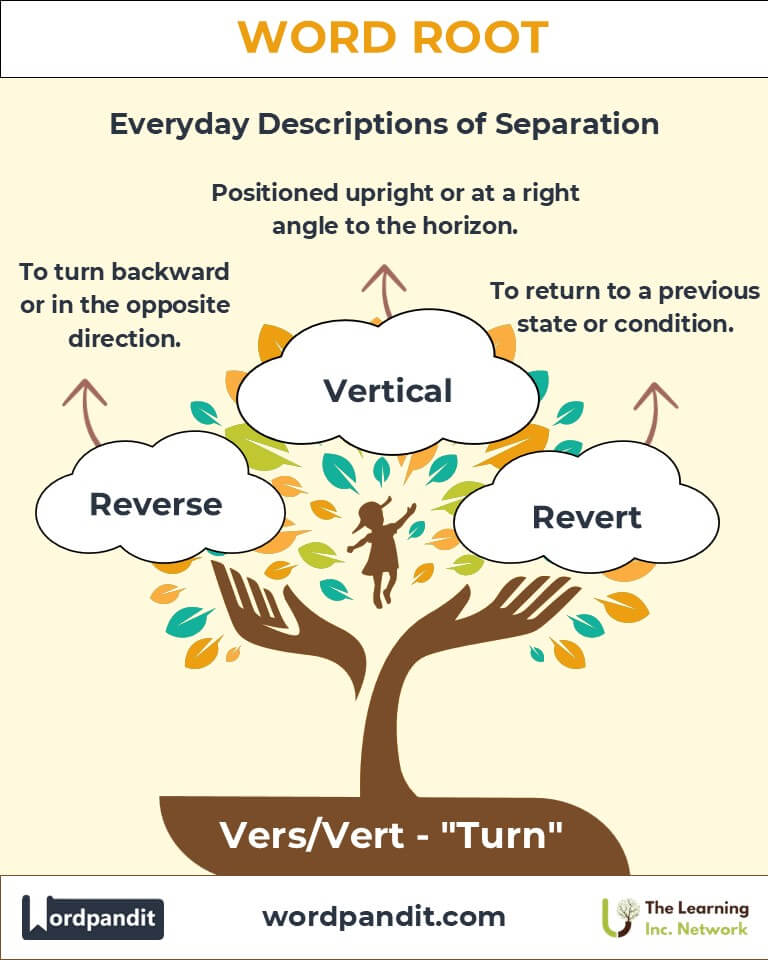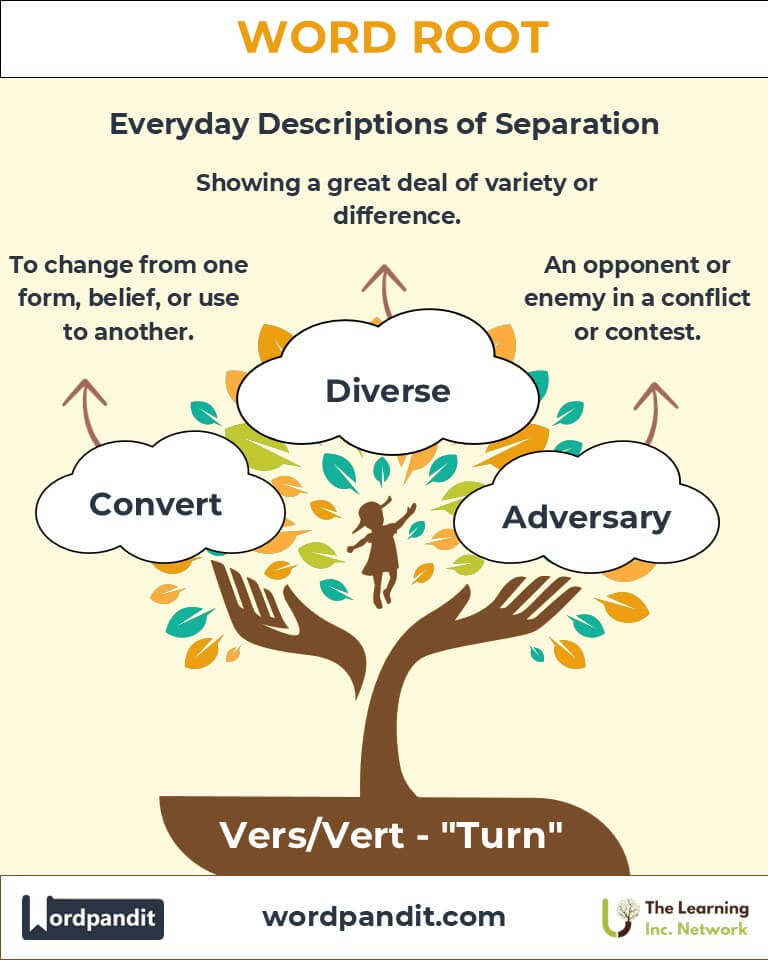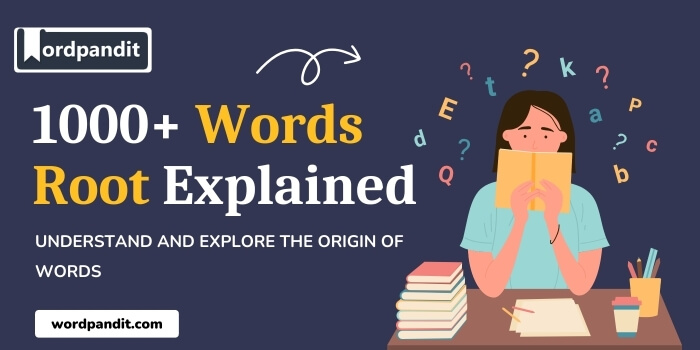Vers and Vert: The Turning Point in Language and Ideas
Discover the rich legacy of the roots "vers" and "vert," derived from Latin and meaning "turn." These versatile roots have given rise to words that symbolize transformation, direction, and change across various fields. From "convert" to "reverse," their impact is deeply embedded in language, art, and culture.

Table of Contents
- Introduction: The Essence of Vers and Vert
- Etymology and Historical Journey
- Mnemonic: Unlocking the Power of Vers and Vert
- Common Vers and Vert-Related Terms
- Vers and Vert Through Time
- Vers and Vert in Specialized Fields
- Illustrative Story: Turning Points with Vers and Vert
- Cultural Significance of Vers and Vert
- The Vers and Vert Family Tree
- FAQs About the Vers and Vert Word Root
- Test Your Knowledge: Vers and Vert Word Root Quiz
- Conclusion: The Living Legacy of Vers and Vert
Introduction: The Essence of Vers and Vert
Have you ever felt the world shift or change direction in an instant? The roots "vers" and "vert," from the Latin vertere, meaning "to turn," encapsulate this dynamic nature of transformation. Pronounced vers (vurs) and vert (vurt), they form the foundation of numerous words that describe physical turning, changes in perspective, or metaphorical pivots in thought and action.
From conversion to reversion, these roots are central to words that signify shifts—be it in faith, form, or function. Their adaptability ensures their relevance across languages, disciplines, and time.

Etymology and Historical Journey
The Latin verb vertere has traveled through centuries, leaving its mark in Romance languages like French (e.g., verser, "to pour or turn") and Spanish (e.g., invertir, "to invert"). It entered English via Middle French, enriching the vocabulary of transformation and direction.
Notably, during the Renaissance, these roots became central to discussions of science and philosophy, emphasizing shifts in knowledge and thought.
Mnemonic: Unlocking the Power of Vers and Vert
Imagine a spinning compass, with its needle constantly turning to find true north. Each turn represents a word derived from "vers" or "vert."
Mnemonic Device: "Vers and Vert are the roots of change, where every turn leads to something new!"
Common Vers and Vert-Related Terms
- Convert (kun-vert): To change from one form, belief, or use to another.
Example: "She decided to convert her attic into a cozy reading nook." - Reverse (ree-vurs): To turn something backward or to the opposite direction.
Example: "The car reversed out of the narrow driveway." - Diverse (die-vurs): Showing a great deal of variety or difference.
Example: "The city is known for its diverse cultural influences." - Adversary (ad-vur-ser-ee): An opponent or enemy in a conflict or contest.
Example: "The chess player faced a skilled adversary in the final match." - Revert (ree-vurt): To return to a previous state or condition.
Example: "After the experiment failed, they reverted to their original method." - Vertical (vur-ti-kuhl): Positioned upright or at a right angle to the horizon.
Example: "The skyscraper soared into the sky in a perfect vertical line."
Vers and Vert Through Time
- Invert (Classical to Modern): Originally denoting a literal turning upside down, this word has evolved to include abstract meanings, such as flipping roles or expectations.
- Reversion (Medieval): Once used in legal contexts to describe property reverting to an original owner, it now broadly applies to any return to a previous state.
Vers and Vert in Specialized Fields
- Medicine: Vertigo describes a condition where one feels as though they or their surroundings are spinning.
Application: Diagnosing balance disorders. - Art and Design: Diverse describes a variety of techniques or styles in creative expression.
Application: Emphasizing inclusivity in exhibitions. - Technology: Convert refers to transforming data or formats (e.g., converting files to PDFs).
Application: Ensures compatibility across platforms. - Business: Adversary is used for competitor analysis in strategic planning.
Application: Helps organizations anticipate market challenges.
Illustrative Story: Turning Points with Vers and Vert
In a small village, Mia, a carpenter, decided to convert her workshop into a community center. Initially met with adversaries who doubted her vision, she stayed persistent. Over time, the space became a hub for diverse cultural events, creating unity and joy. Her journey embodied the transformative power of vers and vert, turning doubt into belief and isolation into connection.
Cultural Significance of Vers and Vert
From the poetic verses of ancient literature to modern discussions on diversity, these roots have played a pivotal role in shaping human expression. They symbolize adaptability and change, reflecting our innate need to pivot and evolve.

The Vers and Vert Family Tree
- Tra- (to pull):
Trajectory: The path of a moving object.
Example: "The rocket’s trajectory was carefully calculated." - Spec- (to look):
Perspective: A particular way of viewing things.
Example: "The painting offers a unique perspective on nature." - Rot- (to roll):
Rotation: Circular movement around an axis.
Example: "The Earth’s rotation causes day and night."

FAQs About " Vers " and " Vert "
Q: What do the roots "vers" and "vert" mean?
A: The roots "vers" and "vert" come from the Latin word vertere, meaning "to turn." These roots are found in many words related to change, direction, or transformation, such as "convert" (to turn completely) and "revert" (to turn back).
Q: What is the difference between "invert" and "convert"?
A: "Invert" means to turn something upside down or inside out, such as flipping a container. "Convert" means to change something into a different form or purpose, such as converting energy into electricity.
Q: How does "extrovert" differ from "introvert"?
A: "Extrovert" describes someone who is outgoing and energized by social interaction, while "introvert" refers to someone who prefers solitude and gains energy from quiet, reflective activities. Both terms share the root "vert," indicating a turning of focus outward or inward.
Q: Why is "advertisement" connected to "vers"?
A: "Advertisement" comes from the Latin advertere, meaning "to turn toward." It refers to messages designed to attract attention or turn the audience's focus toward a product, service, or idea.
Q: What does "versatile" mean?
A: "Versatile" describes someone or something that can adapt or turn easily to different tasks, roles, or situations. For example, a versatile actor excels in many types of roles, and a versatile tool serves multiple purposes.
Test Your Knowledge: " Vers " and " Vert " Mastery Quiz
1. What do the roots "vers" and "vert" mean?
2. Which word describes someone who gains energy from social interaction?
3. What does "invert" mean?
4. What does "versatile" describe?
5. What does "advertisement" aim to do?
Conclusion: The Living Legacy of Vers and Vert
The roots vers and vert remind us of life's dynamic nature, where change and transformation are constant. They encourage adaptability and new perspectives, enriching both language and experience. As these roots continue to shape words and ideas, they inspire us to embrace every turn life offers.












